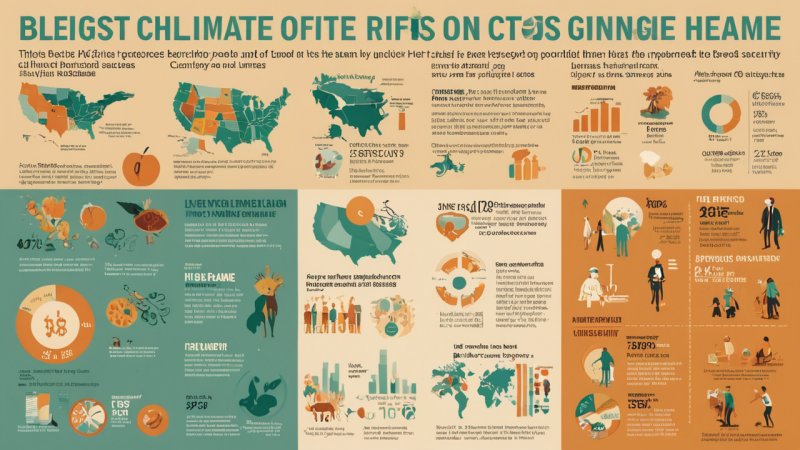Climate change is one of the most pressing issues of our time, impacting not only the environment but also the health of populations worldwide. As global temperatures rise and weather patterns shift, the consequences for public health are becoming increasingly evident. This article delves into the multifaceted relationship between climate change and health, examining the direct and indirect effects, vulnerable populations, and potential solutions to mitigate these impacts.
Understanding Climate Change
Climate change refers to significant and lasting changes in the Earth's climate, particularly a rise in average temperatures due to increased concentrations of greenhouse gases (GHGs) in the atmosphere. These gases, primarily carbon dioxide (CO2), methane (CH4), and nitrous oxide (N2O), are released through human activities such as burning fossil fuels, deforestation, and industrial processes. The consequences of climate change are far-reaching, affecting ecosystems, economies, and human health.
Direct Health Impacts of Climate Change
Heat-Related Illnesses
One of the most immediate health threats posed by climate change is the increase in heat-related illnesses. As global temperatures rise, heatwaves are becoming more frequent and intense. Vulnerable populations, including the elderly, children, and those with pre-existing health conditions, are at a higher risk of heat exhaustion, heatstroke, and other heat-related illnesses. According to the World Health Organization (WHO), heatwaves could lead to thousands of additional deaths each year.
Air Quality and Respiratory Issues
Climate change also affects air quality, leading to an increase in respiratory problems. Higher temperatures can exacerbate air pollution by increasing the formation of ground-level ozone, a harmful pollutant that can trigger asthma attacks and other respiratory issues. Studies have shown that climate change is linked to an increase in hospital admissions for respiratory diseases, particularly in urban areas where pollution levels are already high.
Vector-Borne Diseases
The distribution of vector-borne diseases, such as malaria, dengue fever, and Zika virus, is also influenced by climate change. Warmer temperatures and altered rainfall patterns can expand the habitats of disease-carrying insects, leading to increased transmission rates. For instance, the Aedes mosquito, which spreads dengue and Zika, thrives in warmer climates, and its range is expected to expand as global temperatures rise.
Indirect Health Impacts of Climate Change
Food Security and Nutrition
Climate change poses a significant threat to food security, which in turn affects public health. Changes in temperature and precipitation can lead to crop failures, reduced agricultural yields, and increased food prices. Malnutrition is a direct consequence of food insecurity, particularly among vulnerable populations such as children and pregnant women. According to a report by the Intergovernmental Panel on Climate Change (IPCC), climate change could increase the number of people facing hunger by up to 120 million by 2030.
Water Quality and Availability
Access to clean water is essential for health, and climate change can compromise water quality and availability. Increased rainfall and flooding can lead to water contamination, while droughts can reduce water supplies. These changes can result in waterborne diseases, such as cholera and typhoid fever, which disproportionately affect low-income communities with limited access to healthcare.
Mental Health Impacts
The mental health effects of climate change are gaining recognition as an important public health issue. Natural disasters, such as hurricanes and wildfires, can lead to traumatic experiences and long-term psychological distress. Additionally, the anxiety and stress related to the uncertain future of our planet can contribute to mental health disorders. Vulnerable populations, including those with pre-existing mental health conditions, may be particularly affected.
Vulnerable Populations
Certain groups are more susceptible to the health impacts of climate change due to social, economic, and environmental factors. Vulnerable populations include:
- The Elderly: Older adults often have pre-existing health conditions and may be less able to cope with extreme weather events.
- Children: Children are more vulnerable to heat-related illnesses and respiratory problems due to their developing bodies.
- Low-Income Communities: These communities may lack access to healthcare, clean water, and nutritious food, making them more susceptible to the health impacts of climate change.
- Indigenous Populations: Indigenous communities often rely on natural resources for their livelihoods and may face displacement due to climate change.
Mitigation and Adaptation Strategies
Public Health Interventions
To address the health impacts of climate change, public health interventions are crucial. These may include:
- Heat-Health Action Plans: Implementing plans to protect vulnerable populations during heatwaves, such as providing access to cooling centers.
- Improving Air Quality: Policies aimed at reducing air pollution can have immediate health benefits, particularly for respiratory conditions.
- Vector Control Programs: Strategies to control mosquito populations can help reduce the incidence of vector-borne diseases.
Community Engagement
Engaging communities in climate action is vital for building resilience. Public awareness campaigns can educate individuals about the health risks associated with climate change and promote sustainable practices. Community-based initiatives, such as urban gardening and water conservation programs, can empower individuals to take action.
Global Cooperation
Climate change is a global challenge that requires international cooperation. Countries must work together to reduce greenhouse gas emissions, share research, and provide support to vulnerable nations. Initiatives like the Paris Agreement aim to unite countries in the fight against climate change, with a focus on limiting global warming to well below 2 degrees Celsius.
Conclusion
Climate change poses significant risks to public health, affecting various aspects of life from physical health to mental well-being. The direct and indirect impacts are particularly pronounced among vulnerable populations, highlighting the need for targeted interventions and community engagement. Addressing climate change requires a multi-faceted approach that includes public health initiatives, global cooperation, and individual action. By understanding the intricate links between climate change and health, we can work towards a healthier, more sustainable future for all.






